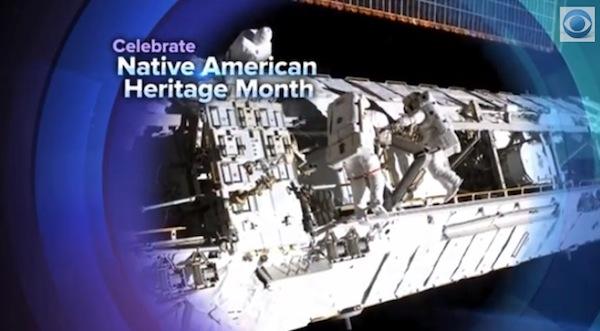
John Herrington, Chickasaw, highlighted by CBS during Native American Heritage Month. He was the first American Indian in space.
11/8/13
John Herrington, Chickasaw, was the first American Indian to take to the stars when he blasted off in the Space Shuttle Endeavour in November 2002.
During Native American Heritage Month he appears on CBS in a short spot bringing attention to Indian contributions to the space program.
“As a Native American astronaut, I was proud to honor my heritage by carrying a Chickasaw Nation flag on a mission to outer space,” he says in the clip.
The astronaut is also a veteran, having served as a U.S. Navy pilot. On the Endeavour mission he worked as the flight engineer on shuttle STS 113, which brought equipment to the International Space Station. With him he carried several mementos from Indian country that had been presented him, including an eagle feather, a flute, arrowheads and some sweet grass “that I think represents a lot of the spiritual sense we all feel,” he told Indian Country Today Media Network on December 1, 2002, as the space station flew over the Pacific Ocean off the coast of South America, just south of the equator.
“I was amazed at how massive the Earth is and looking at the atmosphere how it [is] so small relative to the rest of the Earth and to realize how insignificant we are in the great scheme of things,” he said. “In a spiritual sense it makes you appreciate how grand the grand scheme is of Mother Earth.”
RELATED: John Herrington Speaks to Indian Country Today
Three spacewalks and two delayed landings (due to inclement weather) later, Herrington had returned to that mother, an inspiration to American Indians all over Turtle Island.
“It’s just a deeper feeling—one of your own, finally a Native American,” Deborah Coombs, Oglala Sioux, who works on the shuttle’s parachutes, told Indian Country Today Media Network in 2002 after Herrington’s shuttle landed, assisted by her handiwork. “It’s so important Native Americans be recognized in what they do.”
RELATED: John Herrington, American Indian Astronaut, Returns to Mother Earth
Since then he has been working to get Native children interested in math and science, most notably with a cross-country bicycle ride in 2008 that he named Rocketrek. That’s the same year that another American Indian whose work was key to development of the U.S. space program walked on: Mary Golda Ross, the first Native American female engineer.
RELATED: Native Space Ace Mary Golda Ross (Portrait by America Meredith)
